
Grave Analysis
Many of the later burials found in the Puruchuco cemetery on
the outskirts of Lima, Peru—as seen in "The Great Inca
Rebellion"—showed signs of having died extremely violent
deaths, probably during the Siege of Lima by the Inca. Who
were these ill-fated individuals? As a bioarcheologist, I have
been examining the remains of many of these people. Here,
learn what I was able to determine about one victim's sex,
age, and other characteristics by analyzing that person's
well-preserved skeleton.—Melissa Scott Murphy


|
|
1. Age
Bioarcheologists estimate the age of child and
subadult skeletons based on the maturation of the
skeleton and the development of the
teeth. As seen here, the growth plate
(epiphysis) of her shin bone (tibia) has not fused to
the long bone shaft. The same crack-like space appears
in the upper arm bone (humerus), seen just above the
skull in the main image. In most populations, these
bones fuse between the ages of 13 and 17. I'm guessing
this girl was between 14 and 17 years of age when she
died—shockingly young to perish on a battlefield.
|
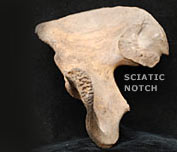
|
|
2. Sex
The
pelvis in men and women features subtle differences,
largely due to the fact that women give birth.
Bioarcheologists can use this disparity to estimate
and/or determine the sex of human skeletal remains. This
young individual was probably female, because her pelvis
exhibits more female traits than male ones. One such
trait is the greater width of the sciatic notch (see
image); in males, it is narrower. Several other female
skeletons turned up in Puruchuco, indicating that some
Inca women fought alongside their men in the Siege of
Lima.
|
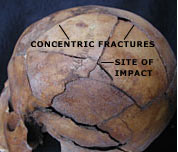
|
|
3. Head wound
Many of the atypical burials recovered from the
Puruchuco cemetery exhibit perimortem (at or around the
time of death) trauma to their skulls, which likely
caused or contributed to their violent deaths. For this
young woman, severe blunt-force trauma caused the
fracture to the left side of her skull. In her
reconstructed skull, four fractures radiate out from the
site of impact, which is also surrounded by concentric
fractures. Her skeleton showed no other injuries. The
woman obviously received a massive and lethal blow,
perhaps from an indigenous stone club.
|
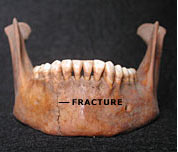
|
|
4. Teeth
All of
the victim's teeth were recovered, and her dental health
was good. She did not possess any cavities or dental
infections, and her teeth showed only slight wear.
However, some of her teeth were chipped when she
sustained the blow to her cranium, and a fracture
radiating across her upper and lower jaws likely also
occurred during her final moments. Though not visible
here, her third molars, aka her wisdom teeth, have not
erupted into her dentition yet, another indication of
her tender age.
|
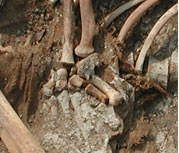
|
|
5. Hands and feet
The only bones from her skeleton that the
archeological team did not succeed in recovering were
some of the small bones (phalanges) of the hands and
feet that make up the ends of the fingers and toes.
Whoever buried her placed one of her hands on her waist
and the other near her chest. Both of her feet were
tucked against her legs.
|
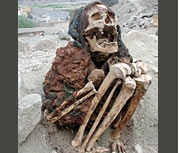
|
|
6. Burial position
In classic Inca burials, including the more
typical Puruchuco burial seen here, the dead were placed
in a crouched, sitting position facing the rising sun, a
symbol of rebirth. By contrast, many of the atypical
burials in Puruchuco were buried facing up or even west.
When interred, this woman, for instance, was placed in a
semi-flexed position on her left side. The lack of a
traditional burial hints at a possible delayed and
rushed interment by a defeated and dispirited people.
|
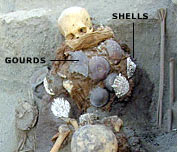
|
|
7. Mortuary offerings
Classic Inca burials from Puruchuco revealed
offerings both within and outside of their cloth
wrappings, as seen here. Inside were often gourd
containers, textiles, foodstuffs, and weaving baskets,
while external offerings included
Spondylus shell, ceramics, wooden canes, and
weaving implements. The burial of the woman in the main
image is remarkable for its total lack of any mortuary
offerings. She was interred with a simple cloth wrapping
called a tela, but nothing else. Perhaps war
parties were still about, requiring a hasty and
non-traditional burial.

|
|


We recommend you visit the
interactive version. The text to the left is provided for printing purposes.
|


|
|
Melissa Scott Murphy is a bioarcheologist at Bryn Mawr College
who has worked in Peru, Israel, and France. She appears in "The
Great Inca Rebellion" as one of the experts working on the
Puruchuco burials.
The Great Inca Rebellion Home |
Send Feedback |
Image Credits |
Support NOVA
|
© | Created
June 2007
|
|









